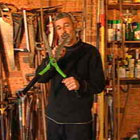Tools need to last for years, so in the long run quality tools are a good investment. Before you go shopping for garden tools, read Don’s handy guide to the jobs tools do, what to look for and how much to pay.
Secateurs:
the basic pruning tool. Buy the best possible, because poor quality secateurs won’t stay sharp and are likely to damage plants. Also, make sure they’re the right size for your hand. Look for secateurs that have replacement blades, can be sharpened and tensioned and have handles shaped for comfort. These may cost a little more, but will last for many years. Left-handed gardeners should buy left-handed secateurs. Felco secateurs cost $77 – $120.
Hedge trimmers: for pruning hedges, shrubs or topiarised plants. Buy good quality hedge trimmers that feel comfortable to use. Don recommends Freund hedge trimmers, which have a curved blade to stop branches sliding out when cutting. Freund hedge shears cost $60 – $80.
Fork: for turning and breaking up clumps of soil, and aerating compost. Today’s forks are adequate, but older designs are more suitable for garden use. Don’s old Spear and Jackson fork is angled to reduce shock to the arms, and its wide prongs make forking up mulch and compost easier. This particular fork is not available anymore, but modern Spear and Jackson forks cost $40 – $90 from major hardware stores.
Shovel: this has a scooped blade (as opposed to the flat blade on a spade), which makes it suitable for moving garden material such as sand and dirt. Choose a size to suit you – small is right for most women, and medium is fine for the average man. Good quality shovels cost $40 – $50.
Spade: this has a flat blade and is used for digging, cutting edges and dividing plants. Most modern spades are fine and a cheap spade will probably do the job. The critical thing with spades is to keep them sharp (bevel the back edge off using a bench grinder or sharpening stone). Good quality spades cost $40 – $50.
Pruning saw: this fits between branches easily and cuts as you pull backwards. It’s for pruning roses and other plants. (A bow saw is better for heavier work and cuts on the forward motion.) Pruning saws cost $27- $55.
Long handled loppers: for cutting branches high up in the air while you stand on the ground. Quality long handled loppers, such as Fiskars, cost around $100.
Garden trowel: for weeding, planting and transplanting. Look for a strong one which won’t bend at the junction between the handle and the blade. Expect to pay around $20 – $45 for a good trowel.
Tool care
If you buy the best quality tools you can afford and look after them, they will perform well for years. Don’t leave them out in the rain! Look after timber handles with regular oiling (50% mineral turpentine and 50% raw linseed oil is best). To keep blades and the edges of spades and shovels sharp, use a bench grinder or a sharpening stone. Squirt some oil on saw blades and anything else that might rust, then rub the oil in with an old cloth. Oiling tool handles and blades is a great job for a rainy day.



